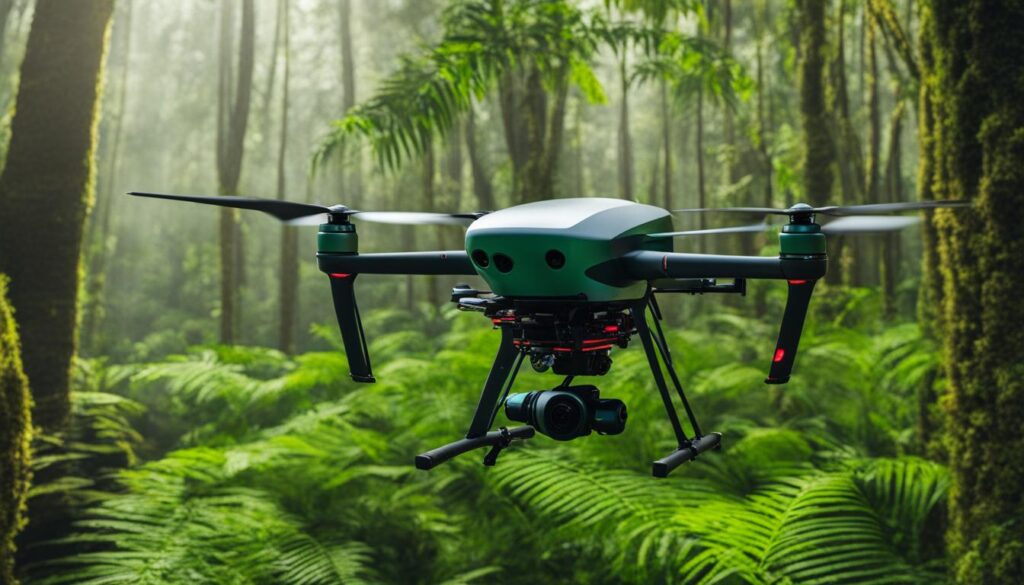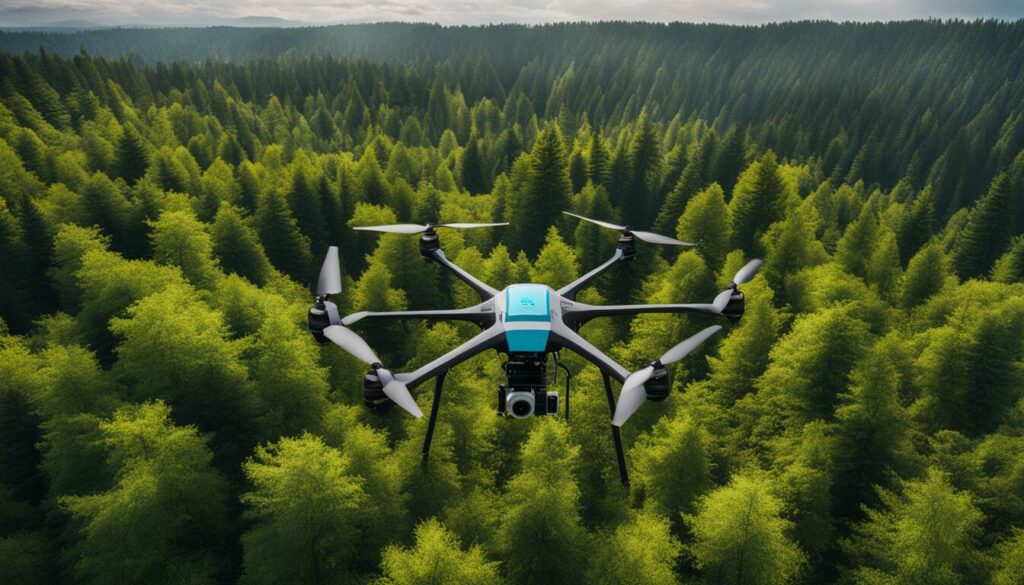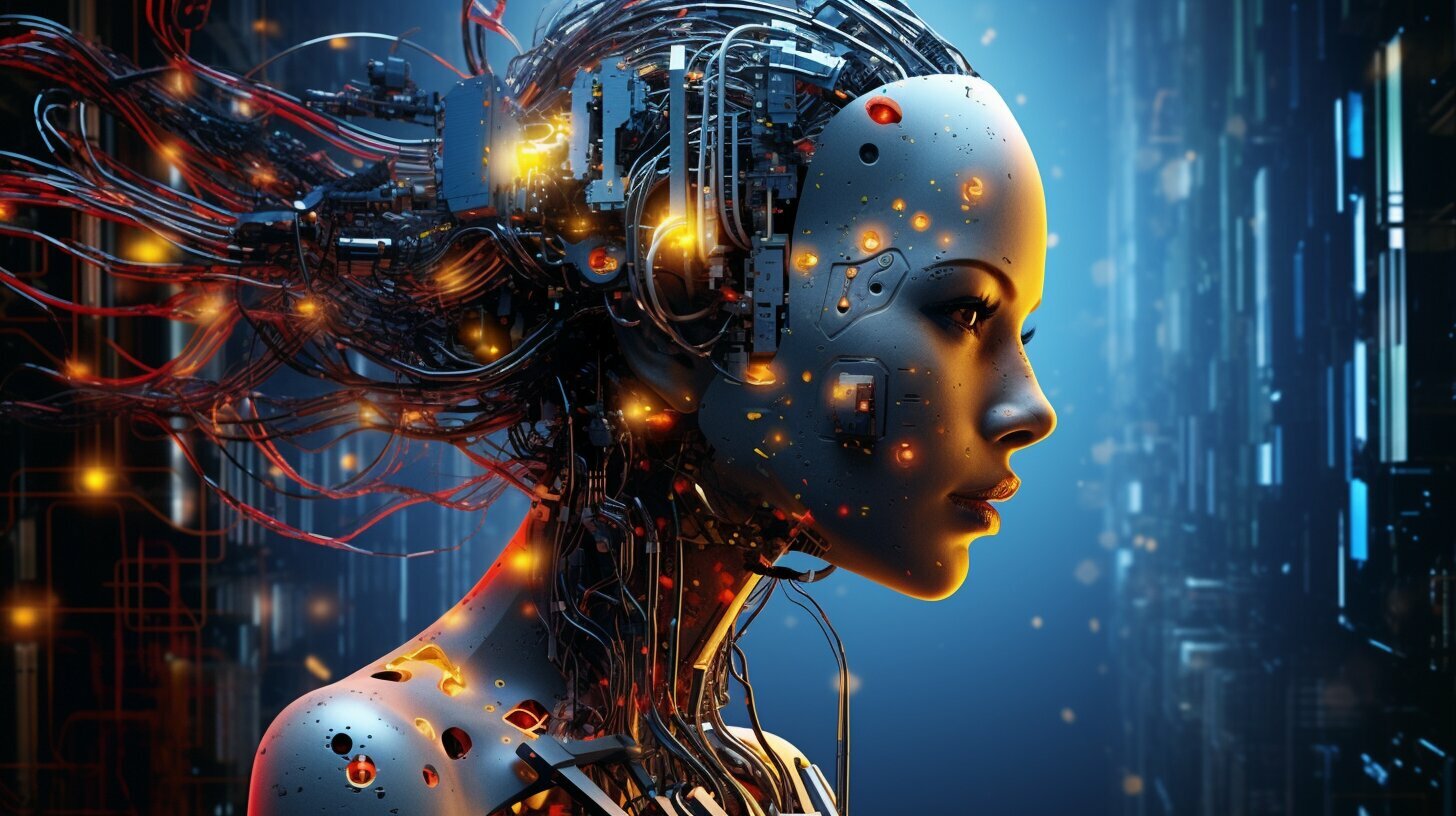Artificial intelligence (AI) has become a game-changer in our quest for sustainable development. With its ability to analyze massive amounts of data, identify patterns, and make predictions, AI is driving innovation in finding solutions to complex environmental challenges.
We are witnessing the rise of “Green AI” solutions that leverage AI technology to combat environmental issues. From detecting deforestation and illegal fishing to optimizing agriculture and improving healthcare, AI is making a significant impact on our journey towards a greener planet.
Key Takeaways:
- AI is a powerful tool for addressing environmental challenges
- Green AI solutions are revolutionizing environmental conservation, sustainable agriculture, and healthcare
- Collaboration between experts and policymakers is crucial for maximizing the impact of AI for the environment
- Ethical considerations such as bias and data security need to be addressed in AI deployment
- AI has the potential to create a sustainable and equitable future
AI Applications for Environmental Conservation
The use of AI technology for environmental conservation is revolutionizing the way we protect and preserve our planet. AI-driven solutions are becoming increasingly valuable in addressing complex environmental challenges and promoting a sustainable future.
One of the key applications of AI in environmental conservation is the analysis of satellite imagery and other data sources to detect activities such as deforestation and illegal fishing. By leveraging AI algorithms, authorities can identify these harmful practices more efficiently, allowing for targeted enforcement efforts and the promotion of sustainable practices.
For instance, AI-powered systems have been instrumental in identifying and tracking illegal logging in the Amazon rainforest. By analyzing satellite imagery and other data, these systems provide valuable insights that help authorities take decisive action against those responsible for deforestation. This technology plays a crucial role in protecting one of the world’s most vital ecosystems.

| AI Applications for Environmental Conservation | Benefits |
|---|---|
| Detection of deforestation | Targeted enforcement efforts, protection of forests |
| Identification of illegal fishing | Preservation of marine ecosystems |
| Analysis of wildlife migration patterns | Protection of endangered species |
By leveraging AI technology, we can detect environmental issues, promote sustainable practices, and protect our natural resources for future generations.
The potential of AI in environmental conservation extends beyond detecting and preventing harmful activities. AI algorithms can also analyze wildlife migration patterns, helping us gain a deeper understanding of their behavior and habitat requirements. This information aids in the protection of endangered species and the preservation of biodiversity.
Overall, AI applications for environmental conservation are making a significant impact in our efforts to create a sustainable planet. By harnessing the power of AI technology, we can address complex environmental challenges, protect our natural resources, and ensure a better future for all.
AI Innovations for Sustainable Agriculture
As we continue to explore the potential of AI for the environment, one area where it is making significant strides is sustainable agriculture. AI algorithms, with their ability to analyze vast amounts of data, are revolutionizing farming practices and helping us move towards a more sustainable and efficient food production system.
By analyzing weather patterns, soil conditions, and crop data, AI algorithms can provide farmers with valuable insights to optimize their farming practices. This includes determining the optimal planting and harvesting times, optimizing irrigation schedules, and even predicting crop diseases. With this information, farmers can make data-driven decisions that lead to increased crop yields, reduced water usage, and minimized use of pesticides and fertilizers.
One noteworthy example of AI in sustainable agriculture comes from India, where AI-powered systems have been used to predict crop diseases and provide farmers with early warnings. By analyzing historical data and weather patterns, these systems can alert farmers to potential disease outbreaks and guide them on the appropriate preventive measures. This not only helps protect their harvests but also minimizes the need for excessive pesticide use, promoting a more sustainable approach to farming.
Table: AI Innovations for Sustainable Agriculture
| Benefit | Description |
|---|---|
| Increase in Crop Yields | AI algorithms analyze various factors such as weather, soil conditions, and crop data to optimize farming practices, resulting in higher crop yields. |
| Reduction in Water Usage | By precisely analyzing soil moisture levels and weather patterns, AI algorithms can help farmers optimize irrigation schedules, reducing water waste. |
| Minimized Pesticide Usage | AI-powered systems can predict crop diseases and pests, allowing farmers to take preventive measures without relying heavily on pesticides. |
These AI innovations in sustainable agriculture have the potential to transform the way we produce food, making it more environmentally friendly and economically sustainable. By harnessing the power of AI, we can create a future where farming practices are optimized, resources are used efficiently, and the impact on the environment is minimized.
Next, we will explore another significant application of AI in improving healthcare in developing countries.
AI for Improving Healthcare in Developing Countries
In developing countries, access to quality healthcare can be a challenge, especially in remote areas with limited resources. However, with the advancements in AI technology, there is hope for improving healthcare outcomes and addressing the unique healthcare needs of these countries. AI algorithms have the potential to revolutionize healthcare by analyzing medical records, genetic data, and other sources to identify patterns and predict disease outbreaks.
By leveraging AI technology, healthcare providers can gain valuable insights and allocate resources more effectively. For example, in Africa, AI-powered systems have been used to predict the spread of diseases like malaria and Ebola. These predictive models enable healthcare providers to proactively respond to potential outbreaks, saving lives and preventing the further spread of diseases.
Furthermore, AI can also assist in the development of targeted interventions and treatment plans. By analyzing a vast amount of data, AI algorithms can identify the most effective treatments for specific diseases and patient populations. This can lead to more personalized and efficient healthcare delivery, particularly in areas where access to specialized medical expertise may be limited.
Table: AI and Disease Outbreaks in Developing Countries
| Disease | AI Solution | Impact |
|---|---|---|
| Malaria | Predictive modeling | Early detection and proactive response to outbreaks |
| Ebola | Pattern recognition | Identification of high-risk areas and timely containment efforts |
| Tuberculosis | Diagnosis assistance | Improved accuracy in identifying cases and initiating treatment |
However, it is important to address the unique challenges and considerations when implementing AI in healthcare. Ethical considerations, such as privacy and data security, need to be prioritized to protect individuals’ rights and ensure responsible use of AI technology. Additionally, it is crucial to validate and continually update AI algorithms to ensure their accuracy and effectiveness in diverse healthcare settings.
With continued advancements in AI technology and increased collaboration between healthcare professionals, technology experts, and policy-makers, we can unlock the full potential of AI for improving healthcare outcomes in developing countries. By harnessing the power of AI, we can bridge healthcare gaps, enhance disease surveillance, and ultimately contribute to a healthier and more equitable world.
Addressing Challenges in AI for the Environment
As we explore the potential of AI for the environment, it is crucial to acknowledge and address the challenges that come with it. One of the main concerns is the potential for bias in AI algorithms. To ensure fairness and avoid perpetuating existing inequalities, we must ensure that AI systems are trained on diverse and representative datasets. By including a wide range of perspectives and experiences, we can minimize the risk of biased outcomes.
Ethical considerations also play a vital role in the use of AI for the environment. Privacy and data security need to be a priority to protect individuals’ rights and maintain public trust. Transparency in AI decision-making processes is essential to ensure accountability and responsible use of AI technology. By incorporating ethical guidelines and standards into AI development and deployment, we can promote the ethical use of AI for the environment.
To overcome these challenges, collaboration among stakeholders is key. By bringing together experts from different fields, including environmentalists, data scientists, policymakers, and ethicists, we can collectively address the challenges of AI for the environment. Through collaboration, we can develop best practices, guidelines, and policies that promote the responsible and effective use of AI technology in tackling environmental issues.
“We must approach AI technology with caution, ensuring that it aligns with ethical principles and values. By doing so, we can harness its power to create positive and sustainable impacts on the environment.” – AI Expert

| Challenges in AI for the Environment | Steps to Address |
|---|---|
| Bias in AI algorithms | Train AI systems on diverse and representative datasets |
| Ethical considerations | Ensure privacy, data security, and transparency in AI deployments |
| Lack of collaboration | Promote collaboration among stakeholders from various fields |
Opportunities for Collaboration and Impact
In order to maximize the impact of AI for the environment, collaboration between domain experts, technology experts, and policy-makers is crucial. By working together, we can identify concrete opportunities for short and medium-term impact, and scale up the use of AI technology in addressing climate change and other environmental challenges.
Collaboration Across Sectors
Cross-sector collaboration brings together the expertise and resources of various stakeholders, enabling us to tackle environmental issues from multiple angles. By combining the knowledge and experience of environmental scientists, AI researchers, technology companies, and policy-makers, we can develop innovative solutions that have a real-world impact.
For example, collaboration between environmental organizations and AI experts can lead to the development of AI-powered systems that can analyze data from remote sensors or satellite imagery to monitor and predict environmental changes. This information can then be used to inform policy decisions and guide conservation efforts.
International Partnerships
International partnerships are also key to leveraging the full potential of AI for sustainable development. By sharing knowledge, best practices, and resources, countries can work together to address global environmental challenges more effectively.
International collaborations can focus on areas such as data sharing, algorithm development, and capacity building. By pooling resources and expertise, countries can accelerate progress in tackling climate change, biodiversity loss, and other pressing environmental issues.
| Benefits of Collaboration | Opportunities for Impact |
|---|---|
| Access to diverse perspectives | More comprehensive solutions |
| Shared resources and expertise | Efficient use of resources |
| Increased innovation and creativity | New approaches to problem-solving |
| Improved scalability and reach | Wider adoption of AI technologies |
Cross-sector collaboration brings together the expertise and resources of various stakeholders, enabling us to tackle environmental issues from multiple angles.
Collaboration is not only important at the international level but also at the local and regional levels. By involving communities, NGOs, and local governments in AI initiatives, we can ensure that solutions are context-specific and address the unique environmental challenges faced by different regions.
Ultimately, by fostering collaboration and partnerships, we can harness the full potential of AI for sustainable development. Together, we can make a difference in creating a more sustainable and equitable future for all.

The Role of AI for Good
| AI Applications | Impact |
|---|---|
| Environmental Conservation | – Detection of deforestation and illegal fishing – Targeted enforcement efforts – Promotion of sustainable practices |
| Sustainable Agriculture | – Optimization of farming practices for increased crop yields – Reduction in water usage, pesticides, and fertilizers – Early warning systems for crop diseases |
| Healthcare | – Identification of disease patterns and outbreak predictions – Effective resource allocation – Proactive response to healthcare crises |
Embracing a Sustainable and Equitable Future with AI
As we look towards the future, it is clear that artificial intelligence (AI) holds immense potential in driving sustainable development and creating a more equitable world. With its ability to process vast amounts of data, AI algorithms can help us tackle complex environmental challenges and pave the way for a sustainable planet.
By leveraging AI technology, we can make significant strides in areas such as environmental conservation, agriculture, and healthcare. AI-driven solutions have already proven their worth in detecting deforestation, illegal fishing, and other harmful activities that impact our environment. This information can be used to target enforcement efforts and promote sustainable practices, safeguarding our natural resources for future generations.
Furthermore, AI innovations are transforming the agricultural sector, empowering farmers to optimize their practices and minimize their impact on the environment. AI algorithms can analyze weather patterns, soil conditions, and crop data to provide valuable insights that lead to increased crop yields, reduced water usage, and a decrease in the use of pesticides and fertilizers. This not only improves agricultural sustainability but also ensures food security and supports rural communities.
AI algorithms can analyze medical records, genetic data, and other sources to identify patterns and predict disease outbreaks. This information can be used to allocate resources more effectively and develop targeted interventions.
In healthcare, AI is revolutionizing the way we approach disease prevention and management, particularly in developing countries. AI algorithms can analyze medical records, genetic data, and other sources to identify patterns and predict disease outbreaks, enabling healthcare providers to allocate resources more effectively and develop targeted interventions. This not only saves lives but also enhances the resilience of healthcare systems in the face of epidemics and other health crises.
However, as we embrace the potential of AI for a sustainable and equitable future, it is essential to address potential challenges. We must ensure that AI systems are developed and trained with diverse and representative datasets to avoid perpetuating existing biases and inequalities. Additionally, ethical considerations such as privacy and data security need to be at the forefront of AI deployment, ensuring responsible and transparent use of this powerful technology.
By harnessing the power of AI and approaching its deployment with caution, we can unlock new possibilities for sustainable development. Together, we can create a future where AI is a force for positive change, enabling us to address environmental challenges, foster equitable growth, and build a better world for all.
Conclusion
In conclusion, AI has the potential to revolutionize the way we address environmental challenges. By leveraging AI technology, we can detect environmental issues, optimize agricultural practices, improve healthcare, and collaborate across sectors for a sustainable future. AI for the Environment offers innovative solutions that can have a lasting impact on our planet and ensure a more sustainable future for generations to come.
However, it is crucial to ensure the ethical use of AI and minimize biases to create a more equitable and sustainable planet. As we embrace AI solutions for sustainability, it is our responsibility to prioritize fairness and inclusivity in the development and deployment of AI systems. By doing so, we can overcome potential challenges and harness the full potential of AI for the environment.
Together, we can unlock the full potential of AI for the environment and make a positive impact. By combining the power of AI with the expertise of domain specialists, technology experts, and policy-makers, we can drive meaningful change and address the pressing environmental issues we face today. Let us embrace AI for the Environment and work towards creating a sustainable and thriving planet for all.
FAQ
How can AI be used for environmental conservation?
AI algorithms can analyze satellite imagery and other data sources to detect deforestation, illegal fishing, and other activities that harm the environment. This information can be used to target enforcement efforts and promote sustainable practices. AI-powered systems have been used to identify and track illegal logging in the Amazon rainforest, helping authorities take action against those responsible.
How can AI contribute to sustainable agriculture?
AI algorithms can analyze weather patterns, soil conditions, and crop data to provide farmers with valuable insights to optimize their farming practices. This can lead to increased crop yields, reduced water usage, and minimized use of pesticides and fertilizers. In India, AI-powered systems have been used to predict crop diseases and provide farmers with early warnings, enabling them to protect their harvests.
How can AI improve healthcare in developing countries?
AI algorithms can analyze medical records, genetic data, and other sources to identify patterns and predict disease outbreaks. This information can be used to allocate resources more effectively and develop targeted interventions. In Africa, AI-powered systems have been used to predict the spread of diseases like malaria and Ebola, enabling healthcare providers to respond proactively and save lives.
What are the challenges in AI for the environment?
One of the main concerns in AI for the environment is the potential for bias in AI algorithms. It is crucial to ensure that AI systems are trained on diverse and representative datasets to avoid perpetuating existing inequalities. Additionally, ethical considerations such as privacy and data security need to be addressed to protect individuals’ rights and ensure responsible and transparent use of AI.
How can collaboration maximize the impact of AI for the environment?
Collaboration between domain experts, technology experts, and policy-makers is essential to maximize the impact of AI for the environment. Cross-sector collaboration can help identify concrete opportunities for short and medium-term impact and scale up the use of AI technology in addressing climate change and other environmental challenges.
What is the role of AI for Good at Element AI?
AI for Good is a dedicated group within Element AI, an AI software product company founded in 2016. The AI for Good team focuses on using machine learning expertise to solve human rights and environmental problems. They collaborate with non-governmental organizations, international organizations, and the public sector to develop reusable AI tools for scaling up and enhancing their work.
How can AI contribute to a sustainable and equitable future?
AI has the potential to unlock new possibilities for sustainable development. From environmental conservation to agriculture and healthcare, AI algorithms are proving to be valuable tools in addressing complex challenges. By approaching AI deployment with caution, minimizing biases, and considering ethical considerations, we can harness the power of AI to create a more sustainable and equitable future.











